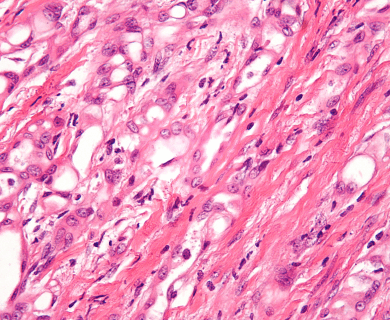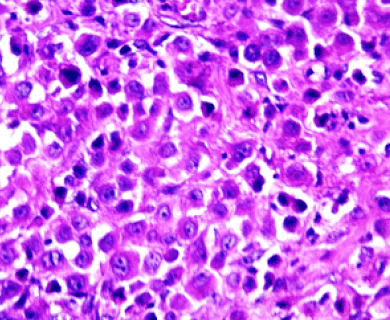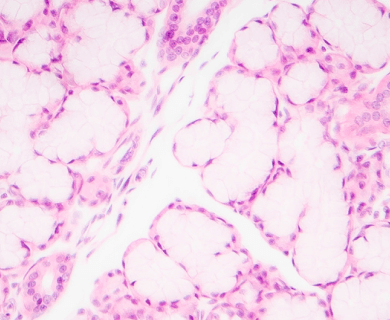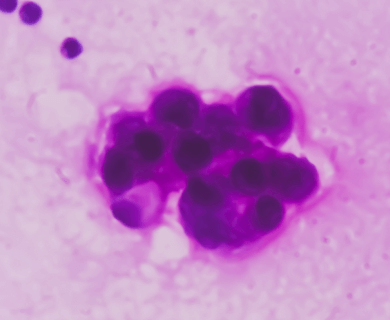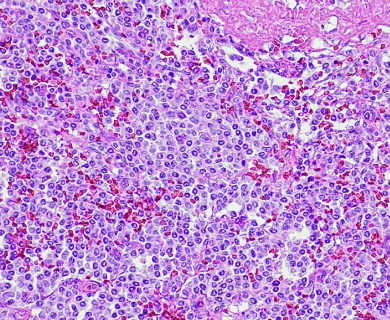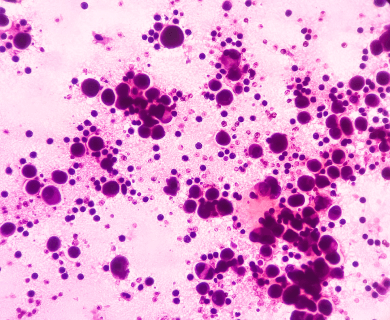Epithelioid Mesothelioma
Epithelioid mesothelioma is a rare cancer caused by asbestos. It accounts for 50% to 70% of all cases, making it the most common mesothelioma cell type. It develops in the lining of the lungs, abdomen or heart. Life expectancy with treatment ranges from 1.2 years to 4.3 years.
Written by Michelle Whitmer | Medically Reviewed By Dr. Jacques Fontaine | Edited By Walter Pacheco | Last Update: October 2, 2024
What Is Malignant Epithelial Mesothelioma?
Epithelial mesothelioma is a type of cancer that develops in the mesothelium. This protective tissue lines vital organs. Asbestos irritates this tissue and is the primary cause of epithelioid mesothelioma.
- About 54% of pleural mesothelioma tumors contain epithelial cells.
- Doctors diagnose 1,500 to 2,100 epithelioid mesothelioma patients annually.
- Epithelial mesothelioma accounts for 50% to 70% of all cases.
- Epithelioid cells comprise about 75% of peritoneal mesothelioma tumors.
- The epithelioid type has the best prognosis of all types of mesothelioma.
Epithelial mesothelioma, or epithelioid mesothelioma, is the most common mesothelioma cell type. It can develop in the lining of the lungs (pleural), abdomen (peritoneal), heart (pericardial) or testes (testicular). Epithelial cells are long (columnar) or square (cuboidal). They indicate a favorable mesothelioma prognosis.
Life expectancy of patients with epithelial mesothelioma is longer than for those with biphasic or sarcomatoid cell types. Epithelial cells respond better than others to aggressive treatment.
Causes of Epithelioid Mesothelioma
Asbestos exposure is the primary cause of epithelioid mesothelioma. Inhaling or ingesting asbestos fibers causes tissue inflammation and DNA damage. This can lead to cancer decades later.
Asbestos fibers cause inflammation in the mesothelium. This lining is made of tissue called epithelium because it’s made of epithelial cells.
The risk factors primarily involve different sources of asbestos exposure. Most people with epithelioid mesothelioma worked with asbestos products before their diagnosis. All mesothelioma cell types have a latency period of 20 to 60 years. The first symptoms may not appear for decades after the initial asbestos exposure. Some people also develop mesothelioma from secondhand exposure.
Malignant epithelial mesothelioma survivor Christine S. told The Mesothelioma Center her dad mixed asbestos cement at work when she was a little girl. She and her mom washed his clothes. She never thought that could cause her own cancer decades later in 2007.
Symptoms of Epithelioid Mesothelioma
Epithelioid mesothelioma symptoms often include cough, shortness of breath and lack of appetite. As the disease progresses, more severe symptoms may appear. Many symptoms depend on tumor location and size.
- Abdominal pain or bloating
- Bowel or bladder changes
- Chest tightness or pain
- Cough, hoarseness or difficulty swallowing
- Difficulty breathing
- Fatigue
- Fever or night sweats
- Fluid buildup in the chest or abdomen (effusion)
- Loss of appetite
- Nausea, vomiting or diarrhea
- Unexplained weight loss
Mesothelioma cancer symptoms are the same, no matter the cell type. Patients with different cell types experience the same symptoms. But the cell type affects which treatments are most helpful. Talk to your doctor if you experience any of these symptoms.

Gain access to top mesothelioma doctors and get help scheduling appointments.
Connect NowDiagnosing Epithelioid Mesothelioma
A tissue biopsy is the only way to diagnose epithelial mesothelioma. This procedure samples suspicious tissue to confirm the cell type under a microscope. Epithelial mesothelioma cells clump together in groups and don’t tend to travel. These cell types are less likely to spread to other areas of the body.
- Diagnosing epithelioid mesothelioma requires a biopsy.
- Imaging scans can show abnormalities, but they alone cannot diagnose cancer.
- Blood tests aren’t helpful for diagnosis, but research is ongoing to make them more effective.
After a biopsy, the pathologist will create a report for your physician. The pathology report describes the mesothelioma cells found in a patient’s tumors. Pathologists use immunohistochemistry tests to identify certain proteins associated with epithelial cells.
Many patients call us to ask questions about their mesothelioma diagnosis. They usually don’t know their cell type. It’s important to ask your doctor about cell type. This will help you understand your symptoms, treatment and prognosis.
Survivor Christine S. told us doctors performed X-rays and other scans because her lungs kept filling up with fluid. Finally, a doctor at another hospital ordered a biopsy. “The result of the biopsy was mesothelioma,” Christine said.
Epithelial Cell Subtypes
Pathologists can identify epithelioid cell subtypes with immunohistochemistry. A specific subtype can influence your treatment options or mesothelioma prognosis. Rare subtypes could lead to a misdiagnosis. Some epithelioid cell subtypes are linked to a better mesothelioma survival rate. The adenomatoid cell type is an example.
Talk to your mesothelioma doctor about your cell type, cancer stage and speed of tumor growth. Ask how these factors affect your treatment plan and prognosis.
Treatment Options for Epithelioid Mesothelioma
Your treatment will depend on the cancer stage, tumor extent and overall health. Doctors often treat epithelioid mesothelioma with a mix of therapies. This is called multimodal therapy.
Early-stage cases typically get aggressive treatment with surgery, chemotherapy and radiation therapy. Late-stage cases respond better to palliative care. This may include immunotherapy, chemotherapy and Tumor Treating Fields therapy.
- Chemotherapy can triple the mesothelioma survival rate.
- Immunotherapy can extend survival to 18 months for many patients.
- Radiation therapy helps manage symptoms and prevent local recurrence.
- Surgery extends survival an average of 2 years or 5 years after HIPEC.
Of the 3 cell types, epithelial mesothelioma responds best to treatment. “The epithelial type does tend to be more favorable,” explains Dr. Wolf. “It does tend to respond to chemotherapy a little more easily.”
Patients may consider a second opinion at a top cancer center. The specialists at these centers have the best experience. They can offer clinical trials and multimodal treatment.

Learn about your diagnosis, top doctors and how to pay for treatment.
Get Your Free GuideWhat Is the Prognosis and Life Expectancy?
The epithelioid mesothelioma prognosis is better than the outlook for biphasic and sarcomatoid cells. Epithelioid cells respond the best to treatment. They don’t spread as quickly as the other cell types, translating into longer survival. Some patients who receive multimodal therapy using two or more treatments live longer.
The 5-year survival rate for epithelioid pleural mesothelioma is 12%. A peritoneal mesothelioma study found a median survival of 55 months in epithelioid patients. Those with sarcomatoid or biphasic cells had a median survival of 7 to 13 months.
It pays to try and stay calm, easier said than done, and go through whatever treatment you have to in order to live longer. And I try to live my life involving family and friends as best I can.
Epithelioid patients live 200 days longer on average than patients with other cell types. The average life expectancy of epithelial malignant mesothelioma patients is 18 months. Early detection and diagnosis at a younger age improve the prognosis. The overall survival of all cell types drops when the disease metastasizes or spreads.
Common Questions About Epithelioid Mesothelioma
- Is epithelioid mesothelioma the same as epithelial mesothelioma?
-
Yes, epithelioid mesothelioma and epithelial mesothelioma refer to the same subtype of mesothelioma. Both terms are used interchangeably in medical contexts.
- Where can I get treatment for epithelial cell mesothelioma?
-
The nation’s top cancer centers have the best resources to treat epithelial mesothelioma. Look for mesothelioma specialists with years of experience treating pleural and peritoneal mesothelioma. Oncologists need training to treat this cell type. Our Patient Advocates and our Doctor Match program can help you find a top doctor who treats epithelial mesothelioma.
- Can epithelioid mesothelioma be prevented?
-
Asbestos exposure is the primary cause of mesothelioma. Avoiding it is the best way to prevent mesothelioma. If you have a history of asbestos exposure, talk to your doctor about cancer screenings. These may aid in an early diagnosis.
- Is epithelioid mesothelioma curable?
-
Unfortunately, epithelioid mesothelioma has no cure. But patients with the epithelioid cell type have the most treatment options. This cell type responds best to all forms of treatment.
- Are there clinical trials available for epithelioid mesothelioma?
-
Researchers look for mesothelioma patients with the epithelioid cell type for clinical trials. These patients have the disease’s most common cell type. Researchers want to know how a treatment will affect most patients with mesothelioma.
- Is epithelioid mesothelioma hereditary?
-
Epithelioid mesothelioma is not considered hereditary. Certain genes may increase the risk of developing mesothelioma after asbestos exposure. Asbestos exposure, not inheritance, is the primary cause of this cancer.


